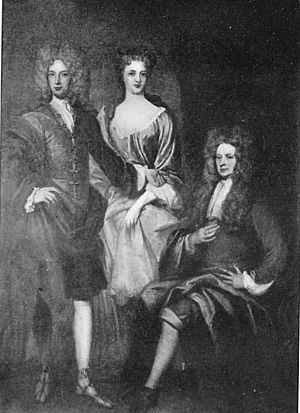George Gordon, 1st Duke of Gordon facts for kids
Quick facts for kids
George Gordon
|
|
|---|---|

George, 1st Duke of Gordon (left) with his children.
|
|
| 1st Duke of Gordon | |
| Reign | 1 November 1684 – 7 December 1716 |
| Successor | Alexander Gordon, 2nd Duke of Gordon |
| Born | 1643 |
| Died | 7 December 1716 Citadel, North Leith |
| Buried | Elgin Cathedral |
| Noble family | Gordon |
| Spouse(s) | Lady Elizabeth Howard |
| Issue | Alexander Gordon, 2nd Duke of Gordon Jane Gordon, Duchess of Perth |
| Father | Lewis Gordon, 3rd Marquess of Huntly |
| Mother | Mary Grant |
George Gordon, 1st Duke of Gordon KT, PC (1643 – 7 December 1716) was an important Scottish nobleman. He was known as the Marquess of Huntly from 1661 until 1684.
Contents
Early Life and Education
George Gordon was born in 1643. His father was Lewis Gordon, 3rd Marquess of Huntly. George became the Marquess of Huntly in December 1653 when he was about four years old.
Following a family tradition, the young Marquess was educated in France. He attended a Catholic school there. In 1673, at age 24, he joined the French Army. He served under the famous Marshal de Turenne. George returned to Scotland around 1675.
Marriage and Family Life
In October 1676, George married Lady Elizabeth Howard. She was the daughter of Henry Howard, 6th Duke of Norfolk. Their marriage was not always easy. The couple separated some years before George's death.
George and Elizabeth had two children:
- Alexander Gordon, 2nd Duke of Gordon (born around 1678, died 1728)
- Lady Jane Gordon (born around 1691, died 1773). She married James Drummond, 2nd Duke of Perth.
A Duke's Rise to Power
On 1 November 1684, George Gordon received a higher title. He became the first Duke of Gordon. This was a very important position.
When the Catholic King James VII came to power in 1685, the Duke gained many roles. He became a Commissioner of Supply. He was also Constable of Edinburgh Castle. He served as a Commissioner of the Scottish Treasury. He was also a founding Knight of the Order of the Thistle. These important jobs were given to him because he was Catholic.
The Glorious Revolution
Later, King James VII was overthrown in what was called the Glorious Revolution. The Duke of Gordon remained loyal to James. He held Edinburgh Castle against the Protestant Conventionists. However, he eventually surrendered the Castle on 14 June 1689.
After this, King James received him coolly at his home in France. When the Duke returned to Scotland, he was kept under watch. His Duchess then left him and went to live in a convent.
Later Years and Legacy
The Duke temporarily regained favor when Queen Anne became queen in 1702. She recognized him as a Knight of the Thistle. She brought the Order back on 31 December 1703.
In March 1707, he was arrested with other Jacobite Lords. Jacobites were supporters of the exiled King James. The Duke was held in Edinburgh Castle. This was because he was involved in a planned Jacobite invasion that did not happen. After this, his Duchess formally separated from him.
The Duke died at his home in the Citadel in North Leith on 7 December 1716. He was buried in Elgin Cathedral. His Duchess returned to Scotland after his death. She lived in Edinburgh until her own death in July 1732. She was also buried in Elgin Cathedral.

